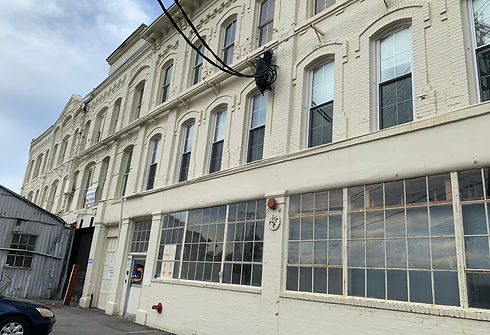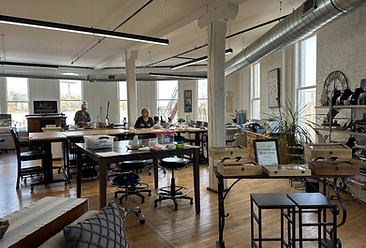

GereBlock
Syracuse, Onondaga County, NY
Built in 1875, the GereBlock once stood as a cornerstone of industry and commerce on Syracuse’s Far West Side. Situated along the historic Erie Canal, the 36,000 sq ft factory bears witness to nearly 150 years of adaptation, expansion, and reuse. Its layered architecture reflects the community’s industrial legacy and its role as a town center. Today, Syracuse’s Far West Side is among the state’s most economically challenged ZIP codes, making GereBlock’s revival both urgent and symbolic: a chance to repurpose the past into a foundation for inclusive, sustainable growth.


The Spark
The project began unexpectedly in 2020. Adam Anderson and Eve De Rosa, professors at Cornell University and co-owners of Eden, a farm-to-table restaurant in Syracuse, were forced to close after only six months due to the COVID-19 pandemic. Determined not to abandon local farmers or disrupt their livelihoods, they launched an online market for farm-to-home delivery. When Eden reopened, there was no longer space for the delivery program, and while searching for a new home for it, they toured GereBlock “on a whim.” Enchanted by its history and potential, they envisioned transforming the factory into a community-centered hub that could carry forward Syracuse’s legacy of connection, commerce, and creativity.
The Project

From the outset, GereBlock grew organically through trust-based networks and word-of-mouth, attracting founders and tenants from historically marginalized groups, including women, gender-diverse individuals, racial and ethnic minorities, and entrepreneurs. Early relationships gradually expanded into partnerships with Cornell University, SUNY Oswego, HopeLab, the Syracuse-Onondaga Food Systems Alliance (SOFSA), Come Out Central New York, 4H, Hugs for Hope, and Singing Solutions, anchoring the site in community-rooted collaboration.
Challenges came quickly. The original developer stepped away after funding fell short, leaving Anderson and De Rosa to stabilize GereBlock both financially and operationally. What could have stalled the project instead sparked innovation. Contractors, architects, designers, and service providers agreed to contribute their labor and expertise in lieu of payment, creating an informal co-op model of shared investment. Their persistence has begun to pay off: GereBlock has received a letter of interest from the Local Initiatives Support Corporation (LiSC), which could unlock nearly $2 million in development awards from Empire State Development, Historic Tax Credits, National Grid, and NYSCA.
Equity & Inclusion
Equity is embedded in GereBlock’s DNA. Tenants and collaborators reflect the neighborhood’s racial, ethnic, and economic diversity. Events are co-designed with community partners, multilingual programming is expanding, and employment pathways are being built through Launch CNY and CenterState CEO’s Racial Equity and Social Impact Division. Partnerships with Indigenous, disabled, and neurodiverse organizations further strengthen accessibility and belonging. GereBlock is designed not only as a workplace but as a welcoming “third place” for connection and co-creation.

Community Impact
GereBlock has become more than a building: it is a symbol of inclusive growth and shared leadership. Located at the intersection of West Fayette Street and Erie Boulevard, the factory sits atop exposed walls of the Erie Canal, a literal and figurative reminder of connection. Just as the canal once linked communities and fueled economic development, GereBlock now bridges past and present, nurturing new opportunities for Syracuse’s Far West Side.

Outcomes and Benefits
1
Established GereBlock as an inclusive hub for economic opportunity, cultural programming, and well-being.
4
Partnered with Launch CNY and Singing Solutions to support disabled and neurodiverse communities.
2
Hosted monthly Queer Community Coworking Days (with Come Out CNY), Global Majority Coffee Hours (with SOFSA), and MWBE workshops (with CenterState CEO).
5
Created tailored programming with Chase Bank and Blue Salt Air for MWBEs and women-owned businesses.
3
Witness to Injustice is provided by the Neighbors of the Onondaga Nation (NOON), and include Haudenosaunee facilitators.
6
Attracted prospective tenants in the creative arts and mental health, ensuring continued growth and diversification.
Reflections
For its leaders, GereBlock is deeply personal. “Preserve. Transform. Revitalize.,” the project’s tagline, captures both the spirit of the building and the commitment required to bring it back to life. What began as a pandemic pivot has become a transformative journey in leadership, resilience, and shared purpose. As Anderson and De Rosa reflect, GereBlock continues to be both a challenge and a promise: proof that conviction and community can reimagine history into a living resource for the future.

Lessons Learned / Transferable Insights
-
Adaptive reuse of historic structures can anchor inclusive, community-centered development.
-
Grassroots, trust-based recruitment fosters authentic diversity and belonging.
-
Creative financing and shared labor investment can sustain momentum even during financial crises.
-
Embedding equity and inclusion from the outset ensures long-term sustainability and impact.
GereBlock demonstrates that historic preservation and community development are not separate endeavors but interwoven acts of care. Once an industrial powerhouse and later an abandoned shell, GereBlock now rises as a vibrant hub of opportunity and connection. It shows how vision, persistence, and collaboration can transform a relic of the past into a cornerstone of an inclusive future.
The Susan Christopherson Center for Community Planning is a project
of the Center for Transformative Action, a registered 501(c)3 organization.
Susan Christopherson Center for Community Planning
Tompkins Center for History and Culture
110 North Tioga St.
Ithaca, NY 14850
© 2025 by Susan Christopherson Center for Community Planning

